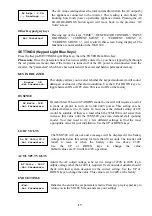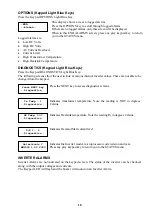
11
SYSTEM MAINTENANCE
To get the optimum performance from your WM1500 power inverter, particularly under heavy
appliance loads, it is essential that the battery bank and the DC wiring all be in good condition. The
small amount of time spent on the maintenance tasks below will maximise the reliability of your
system.
WM1500 MAINTENANCE
Periodic maintenance of the WM1500 inverter involves little more than checking for unobstructed
operation of the cooling fans, which are located on the sides of the inverter. Note that cooling air is
drawn in through the vents in the side of the inverter.
Suggested inverter maintenance should include:
1.
Check for unobstructed fan operation:
Clear away any dust or foreign matter from the fan grill using a soft bristled brush.
(Do not direct high-pressure compressed air at the fan blades)
Note that the fan is designed to come on during heavy power demand.
2.
Check between fins of the heatsink and clean out any accumulated foreign objects, for example,
insect nests.
BATTERY MAINTENANCE
IMPORTANT:
When working on batteries of such high capacity it is essential that you wear protective
clothing, some form of eye protection and rubber-soled work boots. Please regard your
batteries with a great deal of caution, and if in any doubt, entrust this work to your installer.
1.
Every week, carry out a thorough visual inspection of all battery wiring, taking particular note
of the condition of inter-connections between cells.
2.
Check that the stainless steel inter-connecting bolts are tight and have minimal corrosion. If
corrosion is evident, carefully follow the following procedure.
(a) Disconnect the system battery fuse before working on the battery bank.
(b) Unbolt the stainless steel bolts and nuts of any corroded connections and thoroughly clean
the joint with a wire brush or file, taking extreme care not to short circuit any battery cells
with any tools.
(d) Re-assemble and smear a small amount of Vaseline or similar grease over the surface of
the joint to slow down any future corrosion.
3.
Every month or as directed in your battery instruction manual, measure the specific gravity (SG)
of each cell using your hydrometer, to ensure that all cells are performing correctly. Any serious
imbalance should be reported to your system designer in case remedial action needs to be taken.





































